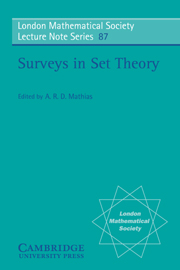Book contents
- Frontmatter
- Contents
- PREFACE
- ITERATED FORCING
- THE YORKSHIREMAN'S GUIDE TO PROPER FORCING
- THE SINGULAR CARDINALS PROBLEM; INDEPENDENCE RESULTS
- TREES, NORMS AND SCALES
- ON THE REGULARITY OF ULTRAFILTERS
- MORASSES IN COMBINATORIAL SET THEORY
- A SHORT COURSE ON GAP-ONE MORASSES WITH A REVIEW OF THE FINE STRUCTURE OF L
- LIST OF PARTICIPANTS
A SHORT COURSE ON GAP-ONE MORASSES WITH A REVIEW OF THE FINE STRUCTURE OF L
Published online by Cambridge University Press: 04 August 2010
- Frontmatter
- Contents
- PREFACE
- ITERATED FORCING
- THE YORKSHIREMAN'S GUIDE TO PROPER FORCING
- THE SINGULAR CARDINALS PROBLEM; INDEPENDENCE RESULTS
- TREES, NORMS AND SCALES
- ON THE REGULARITY OF ULTRAFILTERS
- MORASSES IN COMBINATORIAL SET THEORY
- A SHORT COURSE ON GAP-ONE MORASSES WITH A REVIEW OF THE FINE STRUCTURE OF L
- LIST OF PARTICIPANTS
Summary
Introduction
This paper is based on a series of lectures given at the Cambridge Summer School in Set Theory in 1978. Those lectures were primarily devoted to gap-one morasses, but it seemed reasonable in the context of this paper to review the fine structure of L and collect together the various remarks and modifications circulating in the folklore which together constitute a serious rationalization of this theory as it first appeared in or. I should emphasize that there is little or nothing here which is not already implicit in Jensen's original treatment, and that most of the cognoscenti have probably worked out similar improvements in private. Finally, it's worth noting that the approach taken here becomes practically indispensable when dealing with models other than L; in fact, Jensen and Dodd chose exactly this approach in; my exposition owes much to their treatment.
My approach to morasses owes much to Jensen, of course, but also to Devlin, Silver and Burgess. A notable feature is the early introduction of a less complex structure, the coarse morass, which in a very real sense embodies the condensation arguments needed to prove combinatorial principles like ◊ and ◊+ and which, like these principles, does not need the fine structure theory. As the title indicates, I shall only be concrened with gap-one morasses, thus, unless otherwise indicated “morass” means “gap-one morass”.
- Type
- Chapter
- Information
- Surveys in Set Theory , pp. 197 - 244Publisher: Cambridge University PressPrint publication year: 1983
- 6
- Cited by



